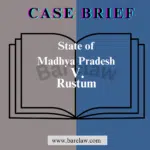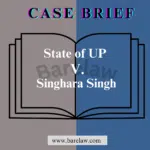
Table of Contents
The Right to Appeal: Satya Pal Singh v. State of MP and the Father’s Quest for Justice
The Right to Appeal: Satya Pal Singh v. State of MP and the Father’s Quest for Justice
Introduction
The Indian legal system is a dynamic tapestry of laws and precedents that aim to ensure justice for all. One significant aspect of this system is the right to appeal, allowing individuals to challenge and seek redressal for legal decisions that they perceive as unjust. In the case of Satya Pal Singh v. State of Madhya Pradesh, a crucial question arose: does the father of a deceased victim have the right to appeal? This landmark case grappled with this issue and established important legal precedents regarding the rights of the victim’s family to seek justice.
Understanding the Right to Appeal
The right to appeal is an integral part of the Indian legal system, enshrined in the Constitution to safeguard the interests of justice. It allows aggrieved parties to challenge the decisions of lower courts and seek a review or reversal of those decisions by higher courts. Appeals are essential to rectify errors, ensure fair trials, and maintain public confidence in the judiciary.
While the right to appeal is well-established for accused individuals in criminal cases and parties in civil disputes, questions have arisen about whether the family members of a deceased victim have the same right when they feel justice has not been served. The case of Satya Pal Singh v. State of Madhya Pradesh brought this question to the forefront.
The Satya Pal Singh v. State of MP Case
The Satya Pal Singh case revolved around a criminal trial in Madhya Pradesh, wherein the accused was charged with the murder of a young woman. The trial court acquitted the accused, leading to immense anguish and disappointment for the victim’s family, especially her father, Satya Pal Singh.
Satya Pal Singh believed that the acquittal was unjust and did not serve the interests of justice. He was determined to seek redressal and justice for his daughter. However, he faced a significant legal hurdle: the absence of a clear legal provision explicitly granting the family members of a deceased victim the right to appeal against an acquittal.
Legal Precedents and the Right to Appeal for Victims’ Families
In India, legal precedents play a vital role in interpreting and applying the law. In the absence of a specific statutory provision, courts often rely on precedents to determine the rights of individuals. In the Satya Pal Singh case, the Supreme Court considered several legal precedents and principles to establish the right of the victim’s family to appeal.
- The Victim’s Status in Criminal Proceedings: Indian courts have recognized the victim’s status in criminal proceedings. While the primary objective of a criminal trial is to determine the guilt or innocence of the accused, the victim’s family has a legitimate interest in seeking justice for the deceased.
- Public Interest Litigation (PIL): Public interest litigation is a powerful tool in Indian jurisprudence, allowing individuals or groups to seek legal remedies for violations of public rights. The Supreme Court has, in various cases, allowed the family of a deceased victim to file PILs in cases of gross injustice, emphasizing the broader public interest in ensuring justice.
- Access to Justice: The right to access to justice is a fundamental right guaranteed by the Indian Constitution. Courts have interpreted this right broadly, recognizing the need to provide a platform for victims’ families to seek justice, particularly in cases where they feel that the legal system has failed them.
- Protection of Victims’ Rights: Various laws and guidelines, such as the Victim Compensation Scheme and the Victim Assistance Program, emphasize the protection of victims’ rights and the need to provide support and redressal to the victim’s family.
Setting Legal Precedents
In the Satya Pal Singh case, the Supreme Court, in a historic judgment, set crucial legal precedents regarding the right of the victim’s family to appeal. The Court held that the father of a deceased victim, like any other aggrieved party, has the right to challenge an acquittal or any legal decision in criminal cases.
The Court emphasized that the legal system should not overlook the pain and suffering of the victim’s family and should provide them with an avenue to seek justice. It stated that denying the victim’s family the right to appeal would be contrary to principles of fairness, justice, and the protection of fundamental rights.
Implications and Significance
The Satya Pal Singh case has far-reaching implications for the Indian legal system and the rights of the victim’s family. It reaffirms the principles of justice, fairness, and equality before the law. The significance of this judgment can be understood through the following perspectives:
- Empowering Victims’ Families: The judgment empowers the families of deceased victims, allowing them to actively participate in the pursuit of justice for their loved ones. It acknowledges their voice and their right to seek redressal.
- Restoring Public Confidence: When the legal system allows victims’ families to appeal, it can restore public confidence in the judiciary. It demonstrates that the system is responsive to the concerns and grievances of the victims’ loved ones.
- Balancing Rights: The judgment strikes a balance between the rights of the accused and the rights of the victim’s family. It ensures that justice is not a one-sided affair but a process that considers the interests of all parties involved.
- Promoting Fair Trials: By allowing appeals from victims’ families, the legal system can potentially improve the quality of criminal trials. It encourages diligence and fairness in the trial process, knowing that decisions may be subject to review.
Challenges and Future Considerations
While the Satya Pal Singh case is a significant step forward in recognizing the rights of victims’ families, there are challenges and considerations for the future:
- Legal Framework: There is a need to develop a comprehensive legal framework that defines the process and procedures for victims’ families to file appeals. Such a framework would provide clarity and guidance to all stakeholders.
- Protection Against Misuse: While empowering victims’ families, the legal system must also guard against potential misuse of the right to appeal. Clear safeguards should be in place to prevent frivolous or vexatious appeals.
- Victim Support: Alongside the right to appeal, there should be greater emphasis on providing support and assistance to victims’ families throughout the legal process. This includes psychological support and guidance.
- Public Awareness: There is a need to raise public awareness about the rights of victims’ families in the criminal justice system. This can help ensure that they are aware of their legal options and can access justice effectively.
Conclusion
The Satya Pal Singh v. State of Madhya Pradesh case marks a significant milestone in the evolution of the Indian legal system. It recognizes the inherent right of the victim’s family to seek justice and appeal against legal decisions they perceive as unjust. This judgment reaffirms the principles of fairness, equality, and access to justice.
While the legal precedents set by this case are crucial, they also highlight the need for further legal reforms and a comprehensive framework to guide the appeals process for victims’ families. By empowering victims’ families and ensuring that they have a voice in the criminal justice system, India can move closer to its ideals of justice and equity for all. The Satya Pal Singh case serves as a testament to the evolving nature of Indian jurisprudence and its commitment to protecting



